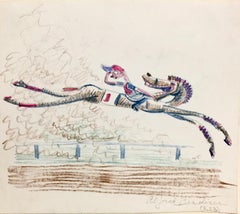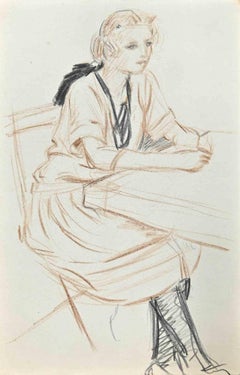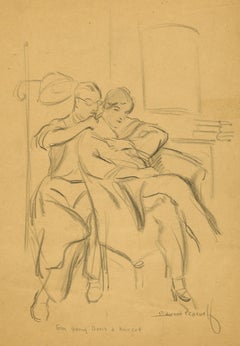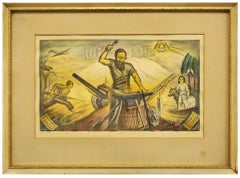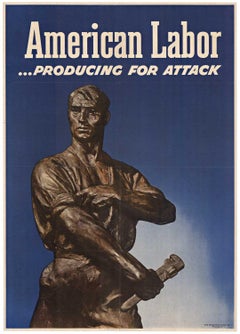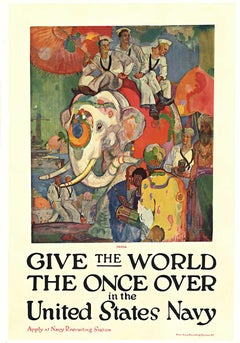Crayon Figurative Prints
to
5
2
Overall Width
to
Overall Height
to
9
7
2
2
1
2
1
1
7
1
4
3
5
5
3
3
1
1
1
1
1
1
1
7,964
7,378
4,750
1,865
1,189
3
3
Style: Modern
Medium: Crayon
The Cry of the Catitipède - Original Handsigned Drawing
Located in Paris, IDF
Yvon TAILLANDIER
The Cry of the Catitipède
Original pastel and graphite drawing
Signed in pencil
On paper 50 x 65 cm (c. 19.6 x 25.5 in)
Very good condition, slight traces of paste...
Category
Late 20th Century Modern Crayon Figurative Prints
Materials
Pastel, Graphite
Horse Laugh
Located in New York, NY
Alfred Bendiner (1899-1964) was trained as an architect but worked as an artist throughout his career. He was a noted lithographer, as well an author, muralist, and caricaturist. The...
Category
Mid-20th Century American Modern Crayon Figurative Prints
Materials
Crayon
The Propeller Pilot - Original Handsigned Drawing
Located in Paris, IDF
Yvon TAILLANDIER
The Propeller Pilot
Original pastel drawing
Handsigned in pencil
On vellum BFK Rives 50 x 65 cm (c. 19.6 x 25.5 in)
Very good condition, slight traces of pastel in...
Category
Late 20th Century Modern Crayon Figurative Prints
Materials
Pastel
The Pupil - Original Drawing - Early 20th Century
Located in Roma, IT
Venus Goddess is an original Drawing in pencil on ivory-colored paper realized by An anonymous artist in the early 20th century.
Good conditions.
The artwork is represented through...
Category
Early 20th Century Modern Crayon Figurative Prints
Materials
Pencil, Pastel
Gin Giving Doris a Haircut
Located in Middletown, NY
A life drawing by a well known book illustrator and long-term resident of the Chelsea Hotel in the 1930s.
Caswell, Edward
Gin giving Doris a hair cut
Black crayon on lightweight, br...
Category
Early 20th Century American Modern Crayon Figurative Prints
Materials
Crayon
AFTER THE VICTORY, PROPHECY OF ISAIAH, WPA ERA Circa 1930s
By Saul Rabino
Located in Surfside, FL
A wartorn composition of a soldier on the left, a Jewish blacksmith in the middle and a little shepherd on the right. This is a lithograph pastel and colored pencil on paper.
Saul Rabino (1892-1969)Best known for his paintings and drawings of Jewish culture, Saul Rabino was a Russian-bornartist who spent most of his life in Los Angeles. Born Saul Rabinowitz in 1892 in Odessa, Russia,Rabino studied art at the Russian Imperial Art School. During a brief stay in Paris, he continued hiseducation at the École des Arts Decoratifs. After mastering techniques in painting, sculpture, andlithography, Rabino moved to Los Angeles, where he worked as a WPA printmaker during the1930s. He stayed in Los Angeles for the rest of his life, making work about political turmoil and theJewish community. During the 1940s, he drew allegorical images of war and the plight of Jewsin Eastern Europe. These political works, usually drawings or prints, are dramatic, symbolic, andemotionally rousing. He also made art portraying the scholars and religious leaders of the Jewishcommunity, including portraits that are more delicate than his political pieces and express anobvious admiration for the leaders of his community. Before he died in 1969, Rabino exhibitedat the World’s Fair New York in 1939, the Los Angeles Museum Historical Society of Art, and theLaguna Beach Art Society. His work is in the collection of the Los Angeles Public...
Category
1930s Modern Crayon Figurative Prints
Materials
Pastel, Color Pencil, Lithograph
At the Beach - Original Pastel - Mid-20th Century
Located in Roma, IT
At the Beach is an original drawing in pastel on creamy paper, realized by an Anonymous artist of the mid-20th Century.
The state of preservation of the artwork is good with some f...
Category
Mid-20th Century Modern Crayon Figurative Prints
Materials
Pastel
Related Items
Original "American Labor ... Producing for Attack" vintage 1943 poster
Located in Spokane, WA
Original AMERICAN LABOR - PRODUCING FOR ATTACK vintage 1943 poster. Size: 19.5" x 22.25. Professional archival linen backed; ready to frame. War Production Board, Washington D.C.
Original. Lithograph. printed by the US Government...
Category
1940s American Modern Crayon Figurative Prints
Materials
Offset
$398 Sale Price
20% Off
H 27.25 in W 19.5 in D 0.05 in
Original 1919, Give the World The Once Over in the United States Navy poster
Located in Spokane, WA
Original 1919 Give The World The Once Over in the United States Navy vintage poster. Archival linen backed. This poster presents itself very fine condition. The lower text por...
Category
1910s American Modern Crayon Figurative Prints
Materials
Lithograph
$2,998
H 42 in W 28.5 in D 0.05 in
Alexander Calder Circus Reproduction Lithograph After a Drawing
Located in Surfside, FL
(after) Alexander Calder
"Calder's Circus" offset lithograph on wove paper after drawings by the artist
Published by Art in America and Perls gallery in 1964 (from drawings done in the 1930's)
these range slightly in size but they are all about 13 X 17 inches (with minor variations in size as issued.) These have never been framed. The outer folio is not included just the one lithograph.
James Sweeny from the introduction “The fame of Calder’s circus spread quickly between the years 1927 and 1930. All the Paris art world came to know it. It brought him his first great personal success. But what was more important, the circus also provided the first steps in Calder’s development as an original sculptor”
Clive Gray wrote ”A visit to the studio of Alexander Calder led to the chance discovery of some hundred masterful circus drawings completed over thirty years ago. We publish, for the first time, a choice of sixteen from that group.” With signed introduction by Miro.
These whimsical drawings, done in the style of wire sculpture, include acrobats, clowns, jugglers, trapeeze artists, an elephant, dog and lion. they are great.
Alexander Calder is widely considered to be one of the most important American sculptors of the 20th century. He is best known for his colorful, whimsical abstract public sculptures and his innovative mobiles, kinetic sculptures powered by motors or air currents, which embraced chance in their aesthetic. Born into a family of accomplished artists, Calder's work first gained attention in Paris in the 1930s and was soon championed by the Museum of Modern Art in New York, resulting in a retrospective exhibition in 1943. Major retrospectives were also held at the Solomon R. Guggenheim Museum (1964) and the Museum of Contemporary Art, Chicago (1974). Calder’s work is in many permanent collections, most notably in the Whitney Museum of American Art, but also the Guggenheim Museum; the Museum of Modern Art; the National Gallery of Art, Washington, D.C.; and the Centre Georges Pompidou. He produced many large public works, including .125 (at JFK Airport, 1957), Pittsburgh (Carnegie International prize winner 1958, Pittsburgh International Airport) Spirale (UNESCO in Paris, 1958), Flamingo and Universe (both in Chicago, 1974), and Mountains and Clouds (Hart Senate Office Building, Washington, D.C., 1976). Although primarily known for his sculpture, Calder was a prodigious artist with a restless creative spirit, whose diverse practice included painting and printmaking, miniatures (such as his famous Cirque Calder), children’s book illustrations, theater set design, jewelry design, tapestry and rug works, and political posters. Calder was honored by the US Postal Service with a set of five 32-cent stamps in 1998, and received the Presidential Medal of Freedom, posthumously in 1977, after refusing to receive it from Gerald Ford one year earlier in protest of the Vietnam War.
Calder moved to New York and enrolled at the Art Students League, studying briefly with Thomas Hart Benton, George Luks, Kenneth Hayes Miller, and John Sloan. While a student, he worked for the National Police Gazette where, in 1925, one of his assignments was sketching the Ringling Bros. and Barnum & Bailey Circus. Calder became fascinated with the action of the circus, a theme that would reappear in his later work.
In 1926, Calder moved to Paris, enrolled in the Académie de la Grande Chaumière, and established a studio at 22 rue Daguerre in the Montparnasse Quarter. In June 1929, while traveling by boat from Paris to New York, Calder met his future wife, Louisa James (1905-1996), grandniece of author Henry James and philosopher William James. They married in 1931. While in Paris, Calder met and became friends with a number of avant-garde artists, including Fernand Léger, Jean Arp, and Marcel Duchamp. Cirque Calder (on view at the Whitney Museum of American Art at present) became popular with the Parisian avant-garde. He also invented wire sculpture, or "drawing in space," and in 1929 he had his first solo show of these sculptures in Paris at Galerie Billiet. Hi! (Two Acrobats) in the collection of the Honolulu Museum of Art is an early example of the artist's wire sculpture. The painter Jules Pascin, a friend of Calder's from the cafes of Montparnasse, wrote the preface to the catalog. A visit to Piet Mondrian's studio in 1930, where he was impressed by the environment-as-installation, "shocked" him into fully embracing abstract art, toward which he had already been tending.
Dating from 1931, Calder’s sculptures of discrete movable parts powered by motors were christened “mobiles” by Marcel Duchamp, a French pun meaning both "motion" and "motive." At the same time, Calder was also experimenting with self-supporting, static, abstract sculptures, dubbed "stabiles" by Jean Arp in 1932 to differentiate them from mobiles.
Public commissions increasingly came his way in the 1960s. Notable examples are .125 for JFK Airport in 1957, Spirale for UNESCO in Paris 1958 and Trois disques, commissioned for Expo 67 in Montreal, Quebec, Canada. Calder's largest sculpture at 25.7 meters high was El Sol Rojo, constructed outside the Aztec Stadium for the 1968 Summer Olympics "Cultural Olympiad" events in Mexico City. Many of his public works were commissioned by renowned architects; I.M. Pei commissioned his La Grande Voile (1966), a 25-ton, 40-foot high stabile for the Massachusetts Institute of Technology.
Part of Calder's repertoire includes pivotal stage sets for more than a dozen theatrical productions, including Nucléa, Horizon, and most notably, Martha Graham’s Panorama (1935), a production of the Erik Satie symphonic drama Socrate (1936), and later, Works in Progress (1968).
In addition to sculptures, Calder painted throughout his career, beginning in the early 1920s. He picked up his study of printmaking in 1925, and continued to produce illustrations for books and journals.As Calder’s professional reputation expanded in the late 1940s and 1950s, so did his production of prints. Masses of lithographs based on his gouache paintings hit the market, and deluxe editions of plays, poems, and short stories illustrated with fine art prints by Calder became available for sale.
One of Calder's most celebrated and unconventional undertakings was a commission from Dallas-based Braniff International Airways to paint a full-size Douglas DC-8-62 four-engined jet as a "flying canvas."
Calder created over 2,000 pieces of jewelry over the course of his career, many of them as gifts for friends and relatives. For his lifelong friend Joan Miró, he set a shard of a broken porcelain vessel in a brass ring. Peggy Guggenheim received enormous silver mobile earrings and later commissioned a hammered silver headboard...
Category
1930s American Modern Crayon Figurative Prints
Materials
Lithograph
"Labor in a Diesel Plant" Machine Age American Scene Industrial Mid 20th Century
Located in New York, NY
"Labor in a Diesel Plant" Machine Age American Scene Industrial Mid 20th Century
Letterio Calapai (American 1902-1993)
''Labor in A Diesel Plant''
Wood engraving, 1940
17 x 10 1/2...
Category
1940s American Modern Crayon Figurative Prints
Materials
Lithograph
$6,900
H 23 in W 16 in D 2 in
Down the River
Located in London, GB
In this sentimental work from 1939, Benton expresses his admiration for the rural lifestyle of the Midwest. He highlights the connection between man and the land by depicting two fig...
Category
1930s American Modern Crayon Figurative Prints
Materials
Lithograph
Prodigal Son
Located in London, GB
A man raises his hand to his chin, his neck tilted and face turned to look at a dilapidated farmhouse, barely held together by planks of wood and exposed to the elements. Behind him ...
Category
1930s American Modern Crayon Figurative Prints
Materials
Lithograph
Discussion
Located in London, GB
In this charming regionalist lithograph, Benton captures a classic Midwestern American scene: two men talking, drinking, and smoking together in a bar. Titled 'Discussion', the artwo...
Category
1930s American Modern Crayon Figurative Prints
Materials
Lithograph
Stag
Located in San Francisco, CA
This artwork titled "Stag" 1957 is an original woodcut on laid paper by noted American artist Leonard Baskin, 1922-2000. It is hand signed and inscribed A.P. (Artist Proof) pencil by...
Category
Mid-20th Century American Modern Crayon Figurative Prints
Materials
Woodcut
"The Fish" Ida Ten Eyck O'Keeffe, Trout, Black and White, Water, Animal Art
Located in New York, NY
Ida Ten Eyck O'Keeffe
The Fish, 1935
Signed and dated in pencil lower right
Monotype on paper
Image 6 x 8 1/2 inches
Exhibited
Dallas Museum of Art, Ida O'Keeffe: Escaping Georgia's...
Category
1930s American Modern Crayon Figurative Prints
Materials
Paper, Monotype
Original "Wonderful Copenhagen" vintage travel poster
Located in Spokane, WA
Original vintage poster: WONDERFUL COPENHAGEN created by the artist Viggo Vagnby. This antique poster is archival linen-backed, in excellent condition, and ready to frame. No da...
Category
1950s American Modern Crayon Figurative Prints
Materials
Lithograph
$1,375
H 39 in W 24.5 in D 0.05 in
Old Man Reading
Located in London, GB
Accompanied by a lantern, an elderly man sits alone, engrossed in a newspaper. Benton used a lithographic process to draw and produce this image. He renders the face and paper well-l...
Category
1940s American Modern Crayon Figurative Prints
Materials
Lithograph
Original 1917 "You Buy A Liberty Bond, Lest I Perish!" vintage poster
Located in Spokane, WA
Original WW1 poster: YOU BUY A LIBERTY BOND, LEST I PERISH! Linen-backed, fine condition. Ready to frame.
Statue of Liberty lithograph, W...
Category
1910s American Modern Crayon Figurative Prints
Materials
Lithograph
$711 Sale Price
20% Off
H 30 in W 20 in D 0.05 in
Previously Available Items
Bundle of "Angel" and "Figures" by P. Puvis de Chavannes
Located in Roma, IT
Angel is an original etching and drypoint realized by Pierre Puvis de Chavannes in the 19th Century.
Good Conditions.
The artwork is depicted through soft strokes in a well-balance...
Category
Late 19th Century Modern Crayon Figurative Prints
Materials
Etching, Pastel, Pencil
Pierre Puvis de ChavannesBundle of "Angel" and "Figures" by P. Puvis de Chavannes, Late 19th Century
H 7.09 in W 10.63 in D 0.04 in
AFTER THE VICTORY, PROPHECY OF ISAIAH, WPA ERA Circa 1930s
By Saul Rabino
Located in Surfside, FL
A wartorn composition of a soldier on the left, a Jewish blacksmith in the middle and a little shepherd on the right. This is a lithograph pastel and colored pencil on paper.
Saul R...
Category
1930s Modern Crayon Figurative Prints
Materials
Pastel, Color Pencil, Lithograph
Crayon figurative prints for sale on 1stDibs.
Find a wide variety of authentic Crayon figurative prints available on 1stDibs. While artists have worked in this medium across a range of time periods, art made with this material during the 21st Century is especially popular. There are many well-known artists whose body of work includes ceramic sculptures. Popular artists on 1stDibs associated with pieces like this include Wedo Georgetti, David Hockney, Alfred Bendiner, and Danilo Bergamo. Frequently made by artists working in the Contemporary, Modern, all of these pieces for sale are unique and many will draw the attention of guests in your home. Not every interior allows for large Crayon figurative prints, so small editions measuring 0.04 inches across are also available
